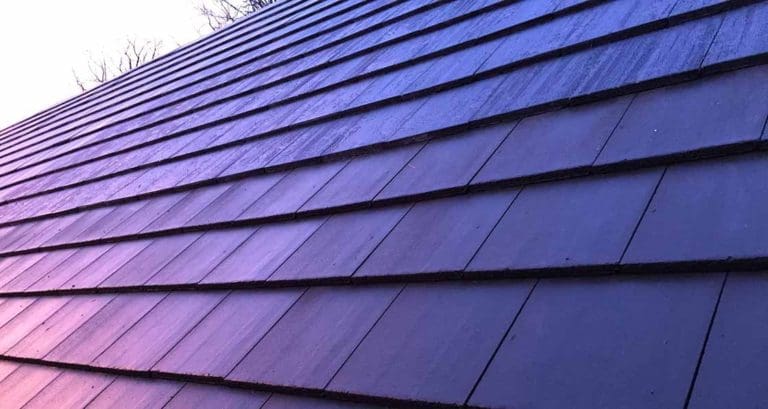
With the average UK household electricity bill increasing by a staggering 70% in October, homeowners all across the country are looking for alternative energy sources as a means to save money.
“Recent developments show photovoltaics like solar slate could be the answer to UK’s energy crisis. A rapid transition to renewable electricity has resulted from rising electricity prices following Russia’s aggression against Ukraine.
“Spain is already transitioning to solar energy to help meet its electricity demands, with requests to install solar panels increasing by 213%. Using solar panels and solar roof tiles, Spain has developed energy communities to help create power through the collection of solar installations. Perhaps in the near future, the UK could develop its own version of energy communities as an effective way to counter high energy prices.’
What are solar roof tiles?
“Solar roof tiles, also known as solar shingles or solar slate, are photovoltaic roof tiles designed to seamlessly blend with the exterior of your home. Solar panels differ from solar slate in that panels are typically mounted onto your roof whereas solar shingles replace the entirety of your roof’s tiling. However, they both function in a similar manner. Utilising solar cells to harness energy from the sun, generating electricity for your home.
The benefits of solar slate
“Solar roof tiles are an aesthetically pleasing alternative to solar panels. The major reason you would want to install solar roof tiles is their elegant appearance. Solar tiles’ ability to blend into roofing, leaving onlookers no the wiser, is its most promising innovation.
“Solar roof tiles act as a replacement roof as opposed to solar panels which are mounted on. Making them the perfect solution for someone living on a listed property or conservation site, looking to innovate their building. Additionally, solar tiles can increase a property’s market value making it a great inclusion when selling a home.
“As building integrated photovoltaics, solar tiles are the future of solar energy generation for UK homes. Once the technology develops further installations such as solar tiles will start to be considered for implementation before construction as a fundamental component of the home rather than being tacked on at the end.
Superb durability
“Solar slate is expertly designed to be durable and long-lasting. When compared to standard roofing, solar slate can handle harsher weather conditions including rain, and hailstorms and is resilient enough to withstand the rigorous force of a hurricane. This toughness guarantees these tiles will last for decades.
Environmentally friendly
“You’ll save money on utilities and the environment with solar roof tiles. These high-tech shingles reduce the CO2 footprint and are a clean, natural source of energy. Similarly, to traditional panels, solar tiles can drastically reduce the annual energy costs of the user by 40% to 70%.
The negatives of solar slate
An expensive alternative to solar panels
“Although they will save you money on energy bills, unfortunately, roof tiles are gonna cost you at least twice as much as installing panels. For comparison, installing a 4KW solar panel system will cost around £6500, whereas a 4KW tile system will cost anywhere from £14000 to £18000. Realistically speaking you would be paying double for a more aesthetic, sleeker solar panel alternative. Opting for solar panels instead is ultimately the more economical option.
Poor efficiency
“Solar roof tiles are less efficient than solar panels. For reference, standard solar panels have an efficiency of 16% and high-efficiency solar panels tend to have an efficiency of up to 22%. Whereas for roof tiles, this is even lower having a range of 10 to 20% efficiency. Unfortunately, solar roof tiles are not on par with solar panels yet. Not only are they more expensive but also less effective at generating energy.
Lacks versatility
“When installing solar slate there isn’t much wriggle room. For an effective source of renewable energy the entire roof space needs to be fitted with solar tiles, partially isn’t an option. The need to sacrifice the whole roof makes solar shingles, which is particularly inconvenient and leads to longer installation times. Fitting solar roof tiles can last anywhere from a single week to a fortnight. However, installing solar panels only takes up to two days until completed.
Should you purchase solar slate?
“Solar tile technology can be a very engaging notion, however, solar panel advancements are yet to make significant strides that would warrant such an investment. On top of that, UK suppliers are relatively scarce at this point in time resulting in high prices. Solar shingles at the moment are purely an aesthetic purchase. If your looking to transform your home with solar power – solar panels are still the way to go.
“Although something to consider is that the solar shingle market size is predicted to see significant growth between 2021 and 2027. This is is the result of people looking to save money on energy bills and the rising environmental concern of fossil-fuel-based energy production among the general public. The spike in individuals looking to assume cleaner methods and products within their daily lives should be identified as the main attribute responsible for the industry’s anticipated growth in the coming years.
“With that said perhaps waiting a few years is the right play until the industry has diversified, with more companies beginning to develop their own solar roof tiles that can at least stand up to panels, giving solar shingles the needed direction to break into the mainstream.”
With thanks to James Evans, at Quality Source. https://www.qualitysource.co.uk/